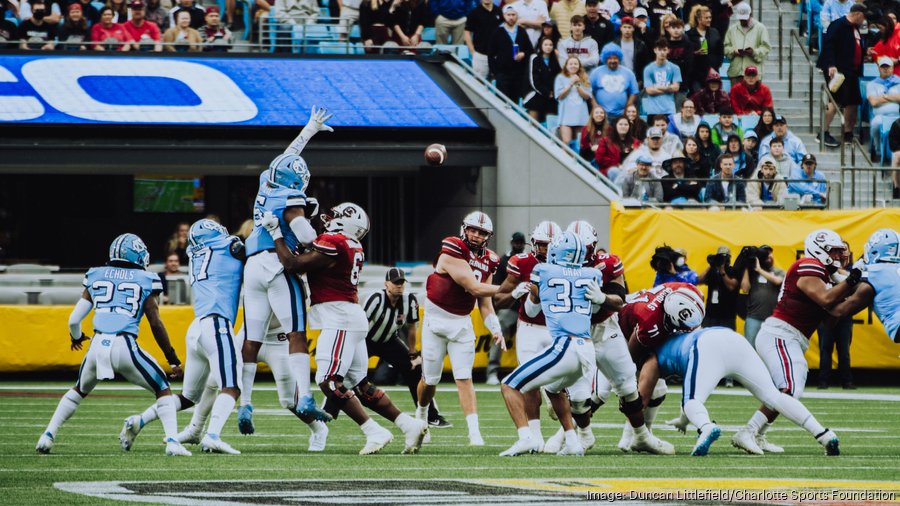Hotel occupancy and room rates during the week of the city’s college football game last month recovered lost ground from 2020 but remain significantly down from pre-pandemic trends, according to data from industry tracker STR.
The Duke’s Mayo Bowl on Dec. 30 at Bank of America Stadium featured a matchup of South Carolina vs. North Carolina — two schools with fan bases within an easy drive of Charlotte. Attendance was 45,520 at the 75,000-capacity stadium.
In 2020, because of a surge in Covid-19 cases, emergency state health regulations limited capacity to 1,500 friends and family at the Charlotte bowl game.
The two days most affected by visits from fans and others associated with the game — Dec. 29 and 30 — created demand for a combined 7,460 rooms, according to STR.
That equates to an occupancy rate of 58.2% in uptown, which has 6,405 hotel rooms. The average room rate paid by guests was $184.73. All those figures are down from 2019, when Kentucky played Virginia Tech in front of 44,138 fans. Note that fans from Kentucky and Virginia Tech mostly came from much farther away, which would necessitate a hotel stay and, in some cases, longer hotel stays than South Carolina-North Carolina.
Overall hotel room demand for the Duke’s Mayo Bowl last month declined 20.2% compared with the 2019 game. Occupancy slipped by 27.9%, affected both by the 2021 participating schools being within easy driving distance as well as greater supply. The number of rooms in uptown grew by 10.7% during the past two years, including the opening of the 381-room JW Marriott Charlotte in August.
Average daily room rates were down by 7.4%, according to STR. All figures were up from 2020, when attendance was limited to 1,500.
Despite not being back at pre-Covid figures, tourism and hotel executives deemed the game a success — particularly in the context of corporate and convention travel remaining in the doldrums because of the Omicron variant.
At the Kimpton Tryon Park Hotel, occupancy for the bowl game improved in comparison to 2019 while room rates declined. Robert Hannigan, Kimpton’s area director of operations, attributed the lower room rates to the proximity of the schools and their fans. Playing so close to home allowed fans who opted to stay overnight in Charlotte to wait for last-minute reduced rates rather than booking farther in advance as fans of Kentucky and Virginia Tech did two years earlier, he added.
“Overall, we were extremely pleased with the Tryon’s performance this year, particularly given we’re still very much in the mix with the pandemic as well as the presence of two stellar hotels in the Grand Bohemian and JW Marriott that were not open in 2019,” Hannigan said.
The 254-room Grand Bohemian opened in August 2020 at Trade and Church streets.
At the JW Marriott, GM David Malmberg said because this is the first year the hotel has been open, there are no bowl week comparisons to draw upon to gauge impact and success.
Rob Cote, GM of uptown hotels AC Hotel by Marriott and Residence Inn by Marriott, told CBJ that those properties saw “very little lift” from the bowl game, mostly because the teams and their fans came from nearby.
A Charlotte Regional Visitors Authority spokesperson said that the visitors authority is in the process of conducting and completing economic benefit studies for the ACC Football Championship played at BofA Stadium on Dec. 5 as well as the bowl game. Between 2016 and 2019, economic impact from the bowl game ranged between $5.9 million and $18.1 million annually, according to previous visitors authority studies.
The Charlotte Sports Foundation, a nonprofit dedicated to increasing tourism through sporting events, owns and operates the bowl game.
Analysts at real estate and investment firm CBRE estimate it will take two to three years before local hotel demand and revenue fully return to pre-Covid levels. For that reason, sports and entertainment events, as well as weekend leisure and family visits, have become more important to stem some of the losses in the hospitality sector.
Mecklenburg County consistently leads the state in tourism spending. In 2020, the most recent full-year data available, North Carolina tourism spending declined 32%. Mecklenburg suffered even more, down 51% from 2019 to $2.8 billion; it is also the state’s top tourism employer, accounting for 26,940 jobs.
The county has 30,812 rooms spread across 243 hotels, according to the visitors authority.
